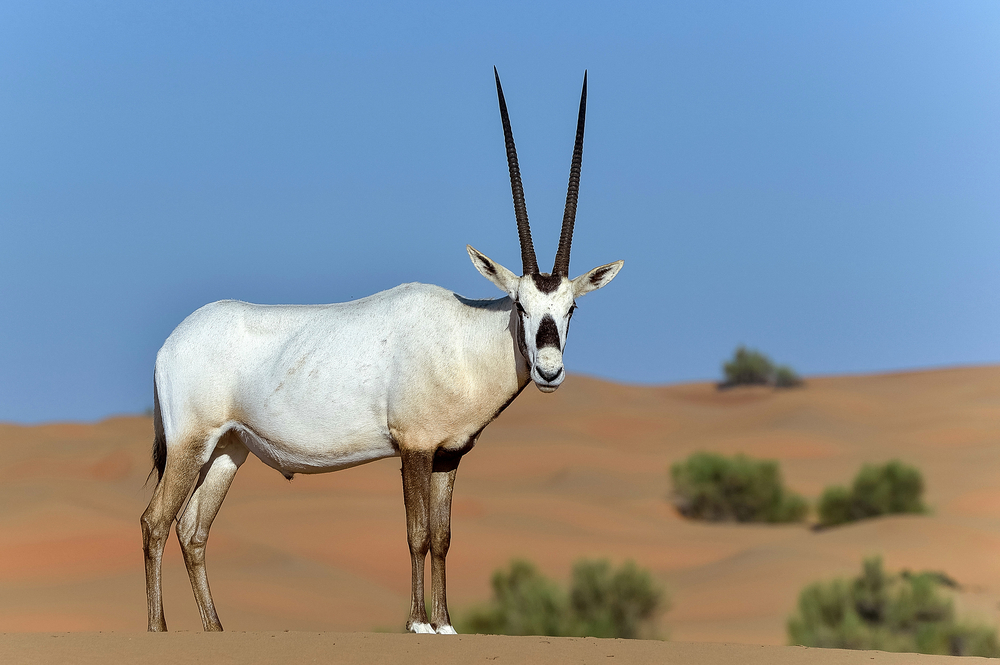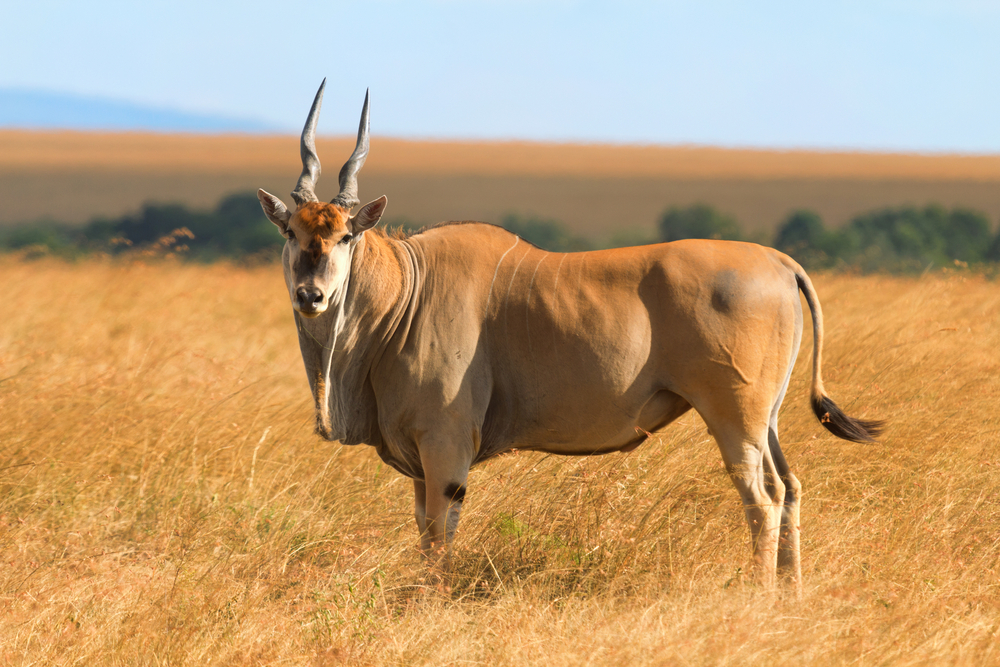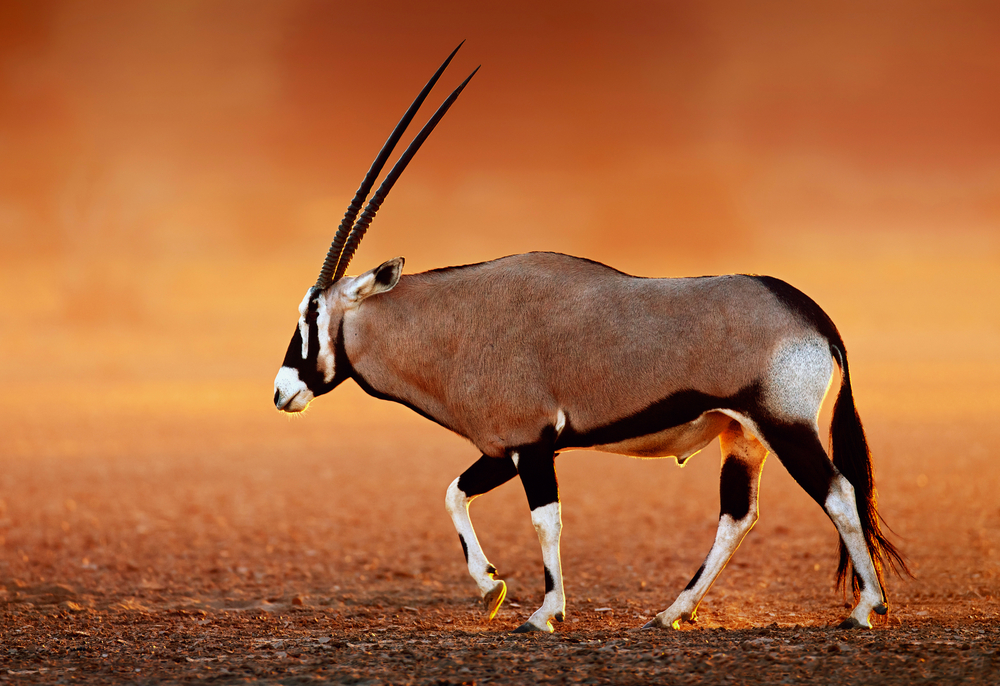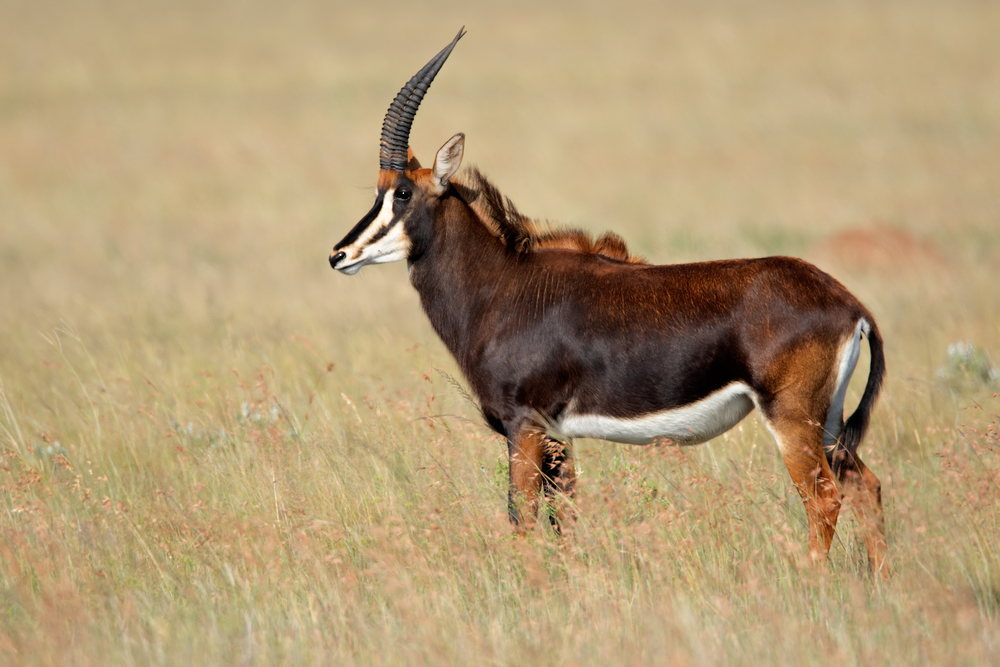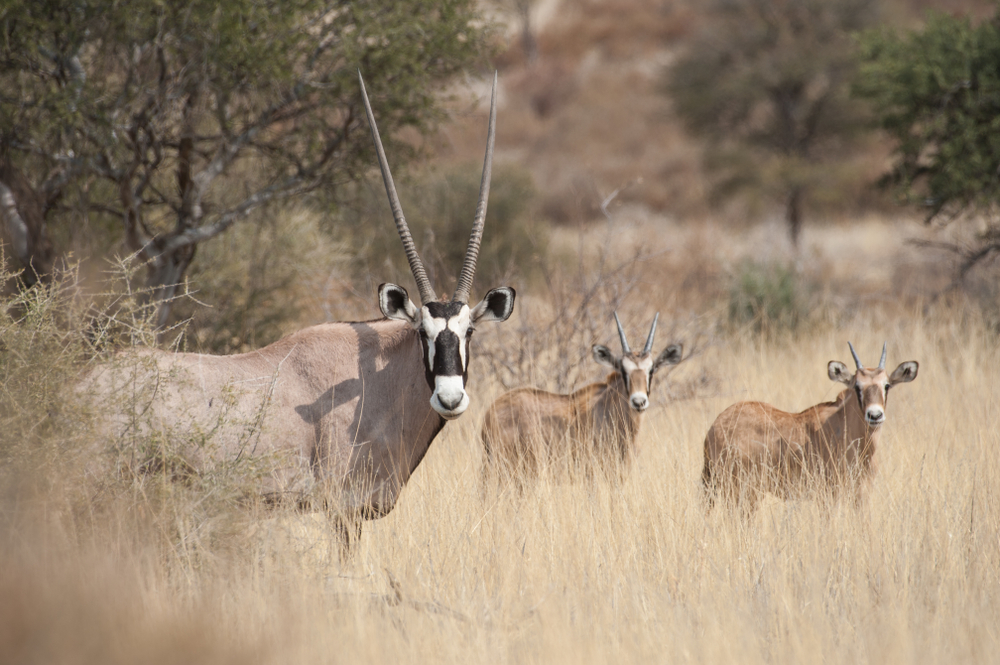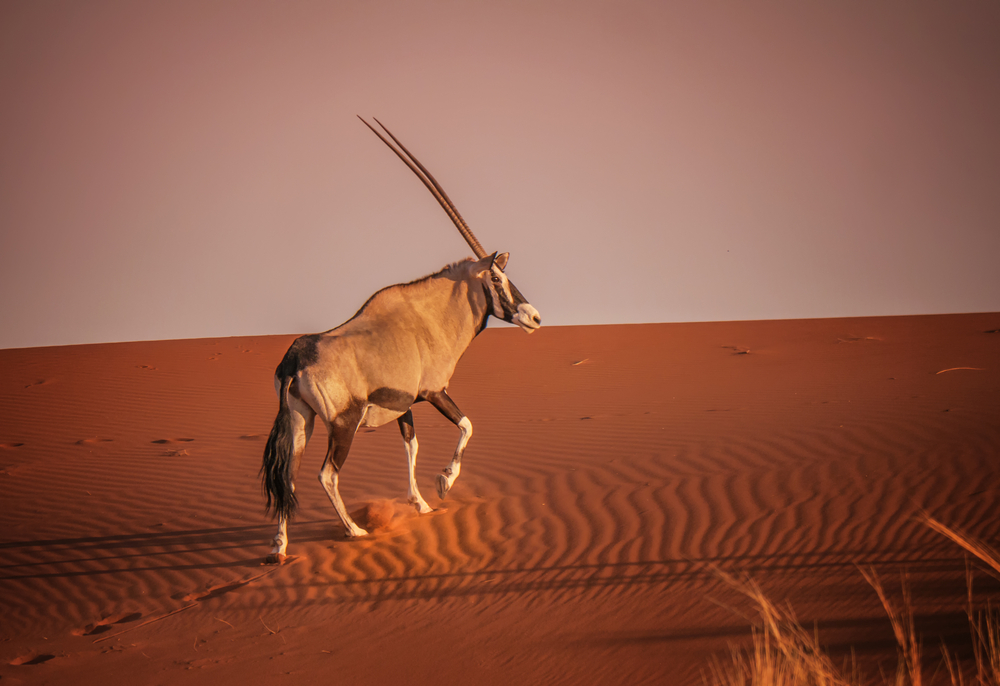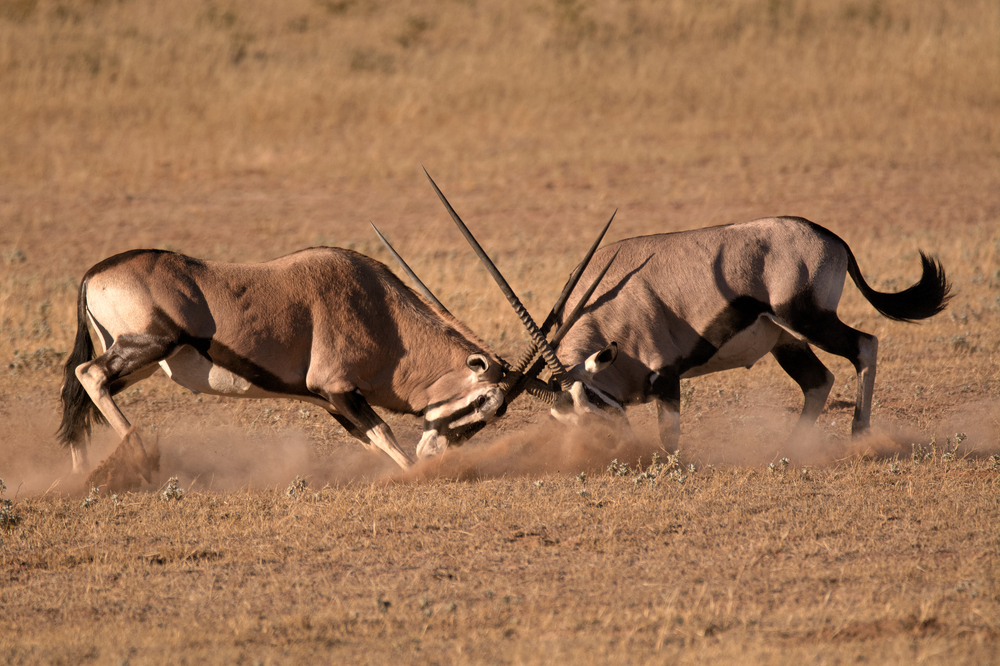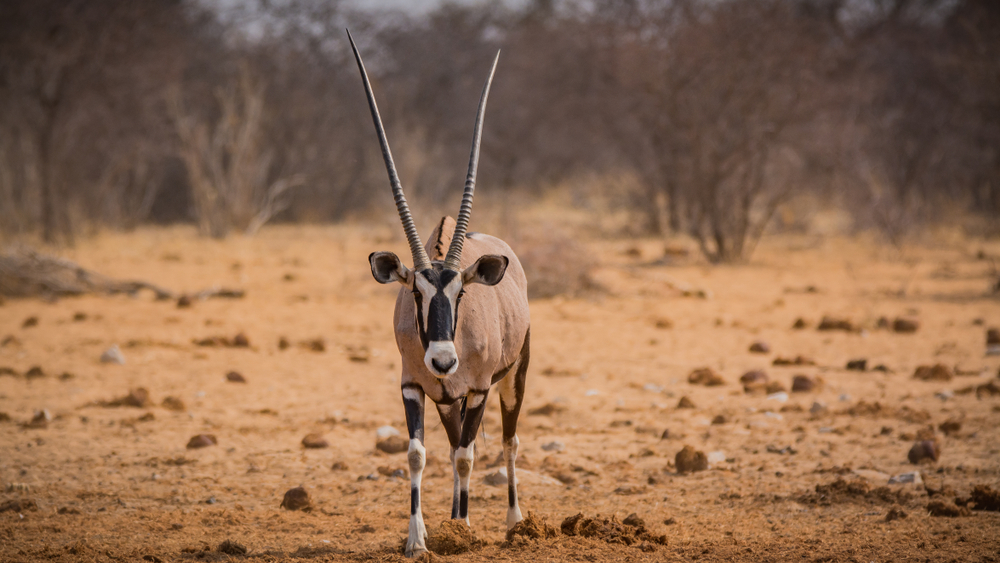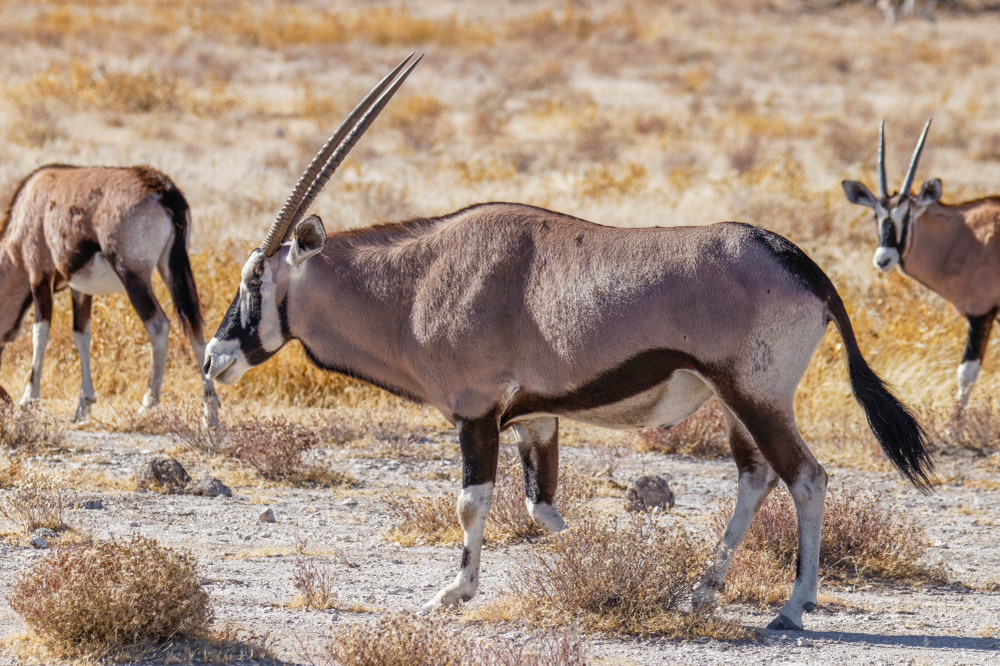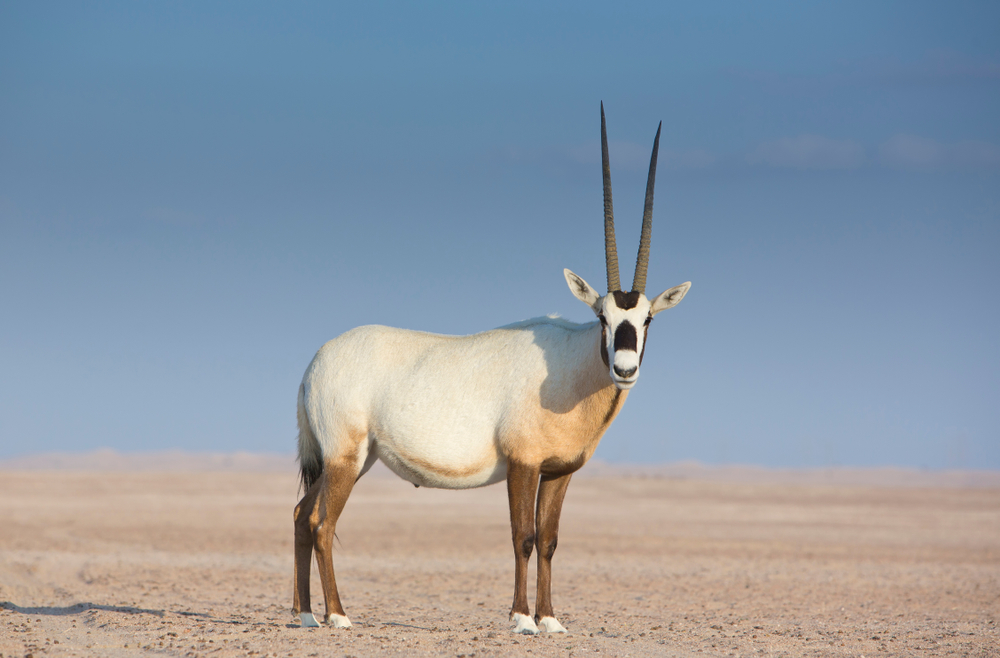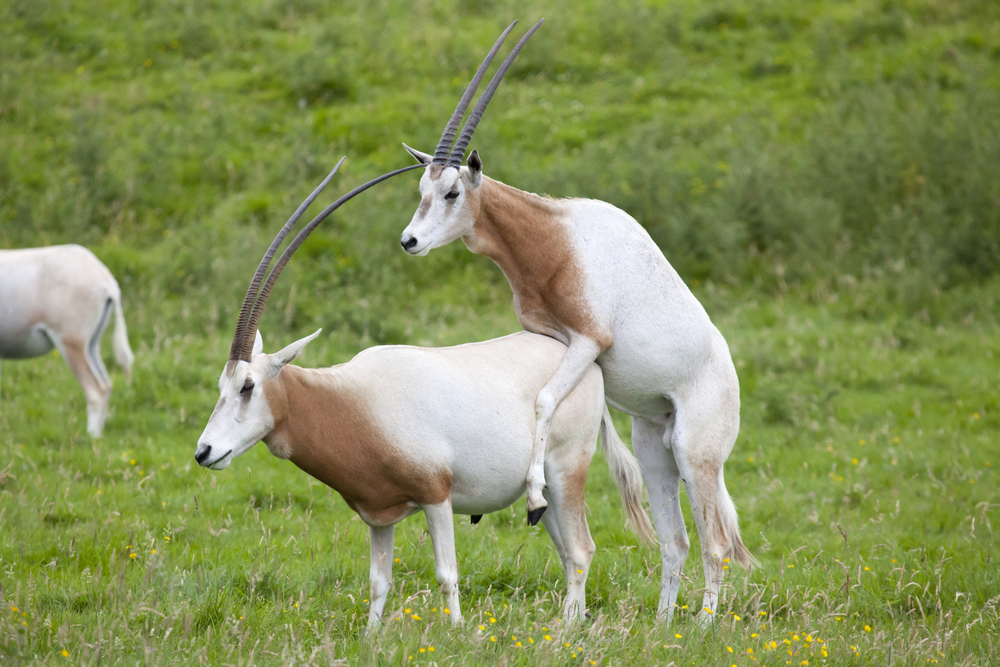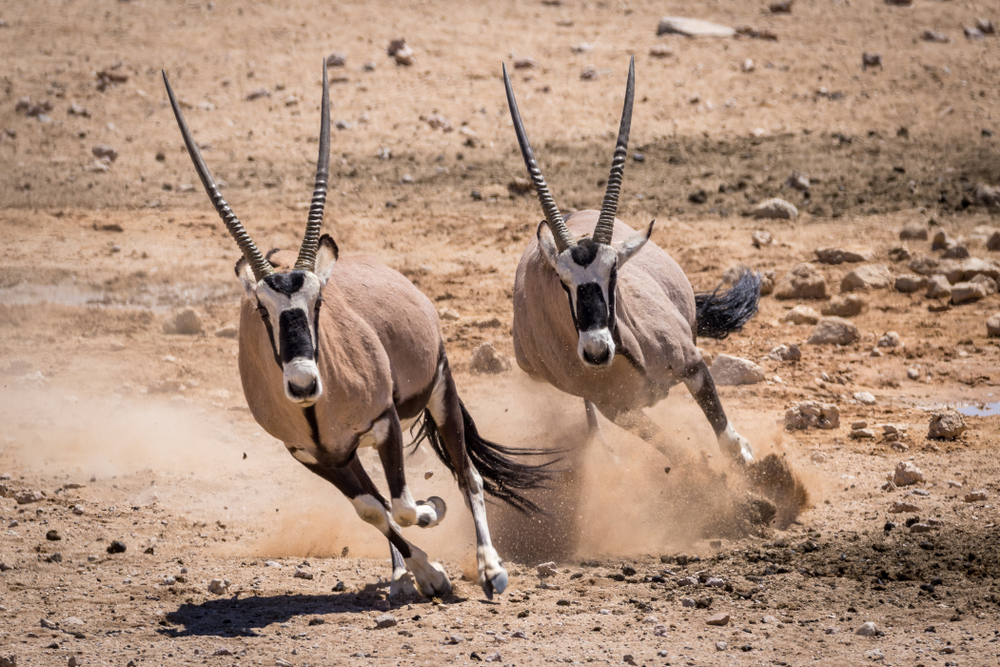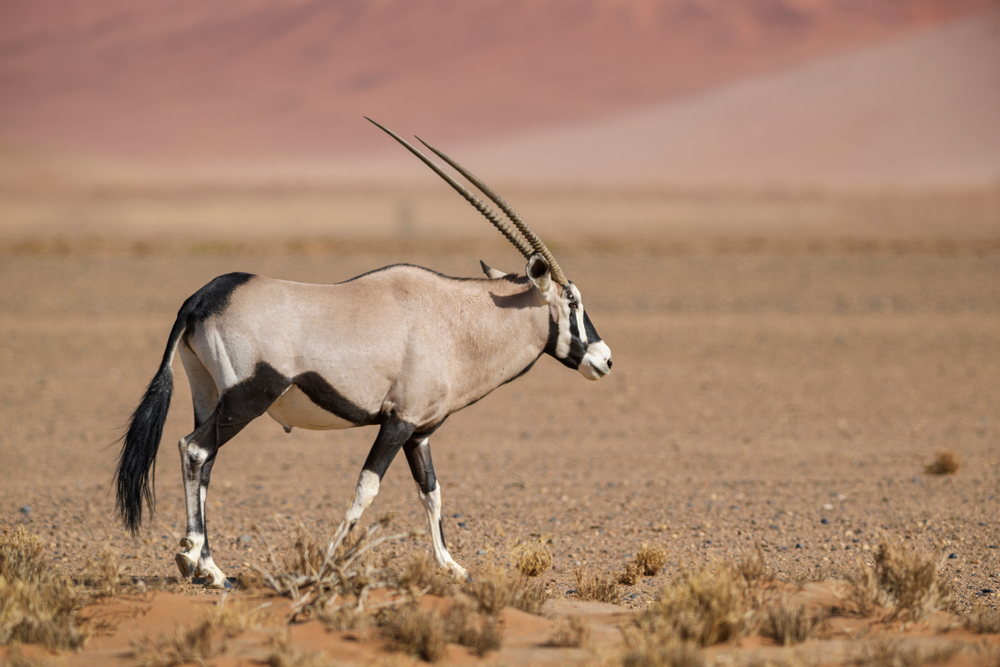About
The Oryx, scientifically known as Oryx gazella, belongs to the Animal Kingdom’s phylum Chordata and class Mammalia. It is a member of the Bovidae family, which also includes antelopes, goats, and sheep. Oryxes are native to arid regions of Africa and the Arabian Peninsula.
These striking antelopes are renowned for their long, straight horns and distinctive facial markings. They have a robust build, with a sandy or whitish coat that helps reflect sunlight in their desert habitats. Oryxes possess excellent adaptation to arid environments, with specialized kidneys that allow them to conserve water and survive in extreme temperatures.
Oryxes are primarily herbivores, feeding on grasses, herbs, and desert shrubs. They have keen senses and are known for their agility and speed, which they use to evade predators such as lions, leopards, and hyenas. Oryx herds often exhibit strong social structures, with individuals cooperating to protect one another from threats.
Conservation Concerns
Several species of Oryx, including the Scimitar-horned Oryx (Oryx dammah) and the Arabian Oryx (Oryx leucoryx), face significant conservation challenges. Habitat loss, overhunting, and competition with livestock have led to population declines and extinctions in the wild.
The International Union for Conservation of Nature (IUCN) Red List categorizes the Scimitar-horned Oryx as extinct in the wild, with efforts focused on reintroducing captive-bred individuals into protected areas. The Arabian Oryx, once extinct in the wild, has seen successful reintroduction programs, although it remains classified as endangered due to ongoing threats.
Conservation efforts for Oryx species include habitat restoration, captive breeding programs, and the establishment of protected areas. Conservationists work to mitigate human-wildlife conflicts, regulate hunting, and address habitat degradation to ensure the long-term survival of these iconic desert antelopes. Continued monitoring and conservation initiatives are essential to safeguard Oryx populations and their arid habitats.
Physical Characteristics
Oryx species, whether it be the Gemsbok, Scimitar-horned Oryx, or other variants, share several common physical characteristics adapted for life in arid environments. Here’s a general physical description of Oryx:
Size:
- Height at Shoulder: Oryx typically stands about 3.3 to 4.6 feet (1 to 1.4 meters) tall at the shoulder.
- Body Length: They have a body length of approximately 6.2 to 7.2 feet (1.9 to 2.2 meters) from the tip of the nose to the base of the tail.
- Tail Length: The tail is relatively short, measuring around 12 to 20 inches (30 to 50 centimeters).
Weight:
- Weight: Adult Oryx individuals generally weigh between 300 to 500 pounds (136 to 227 kilograms).
Physical Characteristics:
- Coat Color: Oryx species often have a pale gray to whitish coat with distinct dark markings on their faces, legs, and flanks. These markings vary among species but often include facial patterns and leg stripes.
- Horns: Oryx have long, straight horns that extend upward and backward from the head. The size and shape of their horns vary between species. Gemsboks, for example, have long, straight horns with sharp tips, while Scimitar-horned Oryx have curved, scimitar-like horns.
- Eyes: They have large, dark eyes with prominent tear ducts, which help reduce glare from the sun and adapt to the bright desert environment.
- Adaptations: Oryx possess physiological adaptations that allow them to conserve water, including specialized kidneys that minimize water loss and an ability to raise their body temperature slightly to reduce perspiration.
The specific size, horn shape, and coloration of Oryx can vary among species and even within populations. These physical adaptations make them well-suited to their arid habitats, where they can endure high temperatures and scarce water sources while thriving in the challenging desert environments of Africa and the Arabian Peninsula.
Reproduction
Oryx, majestic antelope species inhabiting arid regions of Africa and the Arabian Peninsula, have a reproductive cycle adapted to their desert environment. Here’s an overview:
Sexual Maturity: Oryx reach sexual maturity at around 2 to 4 years of age, although environmental conditions such as food availability may influence the timing.
Breeding Season: The breeding season for oryx typically occurs during the cooler months when food and water are more abundant. This seasonality helps ensure optimal conditions for pregnancy and calf survival.
Courtship and Mating: During the breeding season, male oryx engage in displays of dominance and aggression to compete for access to females. Males may spar with rivals using their long, straight horns, establishing hierarchy within the herd.
Gestation: After successful mating, female oryx undergo a gestation period of approximately 8 to 9 months.
Birth and Calf Rearing: Oryx females give birth to a single calf, although twins are rare. Calves are born with a camouflaged coat to help them blend into their sandy surroundings and evade predators. The mother provides attentive care to her calf, nursing it and fiercely defending it against threats.
Weaning and Independence: Calves are weaned at around 6 to 8 months of age but may remain with their mother for up to 2 years, learning essential survival skills such as foraging and avoiding predators. As they grow older, young oryx gradually gain independence from their mother and may join bachelor herds or form their own breeding groups.
Population Dynamics and Conservation: Understanding the reproductive cycle of oryx is crucial for their conservation, particularly in the face of habitat loss, poaching, and competition with livestock. Efforts to protect their natural habitat and manage populations through sustainable hunting and captive breeding programs are essential for ensuring the long-term survival of these iconic desert antelopes
Lifespan
The oryx, specifically referring to the Arabian oryx (Oryx leucoryx) and the scimitar-horned oryx (Oryx dammah), are iconic antelope species native to arid regions of Africa and the Arabian Peninsula. They are well-adapted to harsh desert environments, possessing specialized physiological and behavioral traits that enable them to survive in extreme conditions.
Lifespan in the Wild: In the wild, oryx species typically have a lifespan ranging from 10 to 20 years, although individual lifespans can vary depending on factors such as predation, habitat quality, availability of food and water, disease, and environmental stressors. Oryx have evolved various adaptations to cope with the challenges of desert life, including efficient water conservation mechanisms and the ability to withstand high temperatures.
Lifespan in Captivity: Oryx kept in captivity, such as in zoos, wildlife reserves, and breeding programs, may have longer lifespans compared to their wild counterparts. With proper care, nutrition, veterinary attention, and protection from predators and environmental hazards, captive oryx can live up to 25 years or more. Captive breeding programs play a crucial role in the conservation of endangered oryx species, helping to bolster populations and safeguard genetic diversity.
Threats to the Oryx:
- Habitat Loss and Degradation: Habitat loss due to human activities such as agriculture, urbanization, and infrastructure development is a significant threat to wild oryx populations. Fragmentation and degradation of natural habitats reduce available grazing areas, disrupt migration routes, and limit access to water sources, putting pressure on oryx populations to compete for resources.
- Overhunting and Poaching: Historically, oryx species have been hunted for their meat, hides, and horns, leading to population declines and local extinctions in some regions. Illegal poaching for trophy hunting and traditional medicine continues to pose a threat to remaining oryx populations, particularly in areas with weak law enforcement and inadequate conservation measures.
- Human-Wildlife Conflict: Oryx may come into conflict with human communities over grazing lands, water sources, and agricultural crops, especially during periods of drought or resource scarcity. Retaliatory killings and habitat encroachment further exacerbate human-wildlife conflicts, leading to retaliatory killings and habitat degradation.
- Climate Change: Climate change is altering the distribution and availability of resources in oryx habitats, including changes in precipitation patterns, temperatures, and vegetation composition. These environmental shifts can affect oryx populations’ access to food and water, reproductive success, and overall habitat suitability, increasing their vulnerability to extinction.
- Disease and Parasites: Oryx are susceptible to various diseases and parasites, including viral infections, bacterial diseases, and parasitic infestations. Disease outbreaks can devastate oryx populations, particularly in areas where individuals are already stressed by habitat degradation, food shortages, and human disturbances.
- Invasive Species: Invasive plants and animals introduced into oryx habitats can outcompete native vegetation, degrade habitat quality, and disrupt ecosystem dynamics. Invasive species such as feral ungulates, weeds, and predators pose indirect threats to oryx populations by altering food availability, habitat structure, and predator-prey relationships.
Conservation efforts focused on habitat restoration, anti-poaching patrols, community-based conservation initiatives, captive breeding and reintroduction programs, and climate change mitigation measures are essential for safeguarding wild oryx populations and ensuring their long-term survival. Public awareness, stakeholder engagement, and international cooperation are also crucial for addressing the multifaceted threats facing these iconic desert antelope species.
Eating Habits
Oryx species are well-adapted to arid and semi-arid environments, and their eating habits are specialized to thrive in these challenging habitats. Here’s a description of their eating habits:
Diet:
- Oryx are predominantly herbivorous and primarily graze on a variety of desert grasses and shrubs. Their diet consists mainly of tough, fibrous vegetation that is characteristic of arid regions.
Feeding Behavior:
- Oryx are efficient grazers and are well-suited to feeding on low-quality forage. They have adapted to obtain moisture from their food and can survive without drinking water for extended periods, relying on the water content of the plants they consume.
- They feed during the cooler hours of the day, typically in the early morning and late afternoon when temperatures are more favorable. This helps them avoid the heat of the midday sun.
Selective Feeding:
- Oryx are selective feeders and have evolved to choose the most nutritious parts of plants, such as the tender grass shoots and leaves. They may also target specific plant species that are more palatable and provide better nutrition.
- This selective feeding behavior allows them to optimize their nutrient intake from limited food resources.
Physiological Adaptations:
- Oryx have specialized adaptations to conserve water and minimize water loss. They produce concentrated urine to retain moisture and have efficient kidneys that help them cope with the arid conditions of their habitats.
Social Feeding:
- These antelope often feed in groups or herds, which can provide protection against predators. When one member of the group detects danger, it can alert the others, increasing their chances of survival.
Browsing:
- While grasses are a significant part of their diet, Oryx may also browse on shrubs, leaves, and other vegetation when grasses are scarce or of lower quality.
Water Requirements:
- Oryx can obtain most of their required moisture from the plants they consume, reducing their need to drink water. This adaptation allows them to survive in areas with limited access to water sources.
Oryx’s specialized feeding habits and water-conservation strategies are essential for their survival in arid and semi-arid regions, where food and water resources can be scarce and seasonal. These adaptations enable them to efficiently utilize the available vegetation and minimize their reliance on external water sources, making them well-suited to their harsh desert environments.
Uniqueness
Oryx, also known as gemsbok, are striking and resilient antelope species native to the arid regions of Africa. Here are some key aspects that make oryx unique:
Adaptations to Arid Environments: Oryx are well-adapted to survive in harsh, arid habitats, such as deserts and semi-deserts. They have evolved several physiological adaptations, including the ability to withstand high temperatures and go for extended periods without water. Their efficient cooling system minimizes water loss through sweating and helps them conserve moisture.
Distinctive Appearance: Oryx are easily recognizable by their striking appearance. They have long, straight horns that extend backward from their heads, which they use for defense against predators and to establish dominance within their social groups. Their coats are light in color, ranging from pale gray to sandy brown, with white markings on their faces, bellies, and legs that help reflect sunlight and regulate body temperature.
Social Behavior: Oryx are social animals that typically form small herds consisting of females, young, and a dominant male. These herds provide protection from predators and allow for cooperative behaviors such as mutual grooming and defense of territory. During periods of drought or scarcity, oryx may form larger aggregations around water sources or food.
Nomadic Lifestyle: Oryx are nomadic animals, constantly on the move in search of food and water. They have large home ranges and are capable of traveling long distances in search of resources. Their ability to adapt to changing environmental conditions allows them to thrive in unpredictable and often inhospitable habitats.
Efficient Grazers: Oryx are predominantly grazers, feeding on grasses, herbs, and shrubs found in their arid habitats. They have specialized digestive systems that allow them to extract moisture and nutrients from tough, fibrous vegetation, making them well-suited to their diet.
Conservation Success: Some species of oryx, such as the scimitar-horned oryx, have faced significant declines in the wild due to habitat loss, poaching, and competition with livestock. However, conservation efforts, including captive breeding and reintroduction programs, have led to successful population recoveries in certain areas. The scimitar-horned oryx, for example, has been reintroduced to several protected areas in its historic range.
Cultural Significance: Oryx hold cultural significance in the regions where they are found, featuring prominently in folklore, art, and traditional ceremonies. They are often revered for their resilience, strength, and adaptability, symbolizing survival and endurance in challenging environments.
Oryx’ unique adaptations to arid environments, distinctive appearance, social behavior, and conservation success stories make them iconic symbols of the African savanna and exemplars of nature’s resilience in harsh conditions.
Sources
- Alden, Peter et al, National Audubon Society Field Guide to African Wildlife, New York, NY.
- Britannica, Oryx, https://www.britannica.com/animal/oryx, January 2024.
- Burnie, David & Wilson, Don, Animal, Smithsonian Institute, Washington DC.
- Clutton-Brock, Juliet and Wilson, Don, <a class="wpil_keyword_link" href="https://animalkingdom.org/animals/mammals/" title="Mammals" data-wpil-keyword-link="linked" data-wpil-monitor-id="146">Mammals</a>, Smithsonian Handbooks, New York, NY.
- Hickman et al, Integrated Principle of Zoology, McGraw Hill, Boston.
- Nolting, Mark, Africa’s Top Wildlife Countries, Global Travel Publishers, Inc., Ft. Laurderdale, FL.



































































